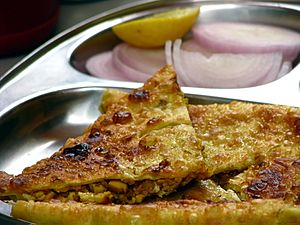Stuffing facts for kids
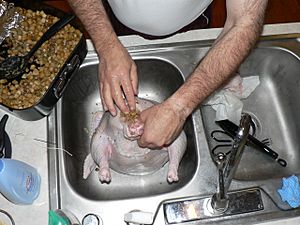
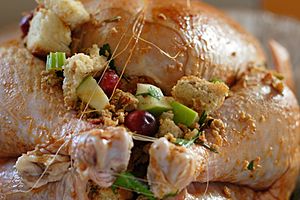
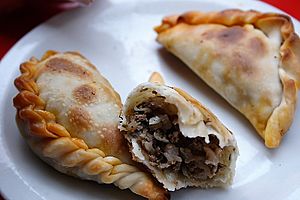
Stuffing, also known as filling or dressing, is a yummy mix of ingredients. People use it to fill a space inside another food item. This mix often includes herbs and a starch, like bread. Many different foods can be stuffed. These include poultry (like chickens or turkeys), seafood, and even vegetables. When you stuff food, it helps keep the main food moist while it cooks. The stuffing itself also soaks up and adds amazing flavors.
Stuffing for poultry often has breadcrumbs, onion, celery, spices, and herbs such as sage. Sometimes, people add the bird's giblets (like the liver or heart) to the mix. In the United Kingdom, some stuffings also include dried fruits and nuts, such as apricots, flaked almonds, or chestnuts.
Contents
What is Stuffing?
Stuffing is a mixture that goes inside other foods. It adds flavor and moisture to the main dish. Think of it like a delicious surprise hidden inside your meal!
A Look Back in Time
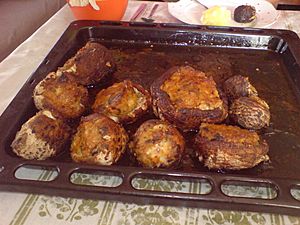
No one knows exactly when people first started using stuffings. The oldest known recipes for stuffed foods come from an ancient Roman cookbook. It is called De Re Coquinaria. This book has recipes for stuffed chicken, dormouse, hare, and pig. Most of these old stuffings used vegetables, herbs, spices, nuts, and spelt (an old grain). They often also had chopped liver or other organ meat.
Over time, stuffing got different names. Around the year 1390, it was called "farce." Later, in 1538, the word "stuffing" appeared. In 1688, people used "forcemeat." In the United States, the name "dressing" became popular around 1850.
Where Do We Stuff Food?

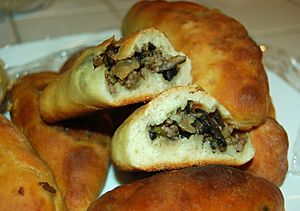
People often stuff the main body space of animals like birds, fish, and mammals. But you can also stuff different cuts of meat. This is done after removing bones or by cutting a pocket into the meat. Some popular examples include stuffed chicken legs, stuffed pork chops, and stuffed breast of veal. Of course, the traditional holiday turkey or goose is also often stuffed.
Many vegetables are also great for stuffing. You just need to remove their seeds or some of their inside flesh. Tomatoes, capsicums (sweet or hot peppers), and vegetable marrows (like zucchini) can all be prepared this way. Cabbages and similar vegetables can also be stuffed. Their leaves are usually blanched (briefly boiled) first to make them soft and easy to bend. Then, you can either replace the inside of the vegetable with stuffing or put small amounts of stuffing between the leaves.
Ancient cooks even came up with recipes for stuffing animals inside other animals! For example, an old cookbook from the 13th century (from a place called Al-Andalus) has a recipe for a ram stuffed with small birds. Today, we have dishes like the Turducken, which is a turkey stuffed with a duck, which is then stuffed with a chicken!
What Goes Inside?
Almost anything can be used as a stuffing! Many stuffings in English-speaking countries use bread or cereals. These are usually mixed with vegetables, herbs, spices, and eggs. In the Middle East, vegetable stuffings often use seasoned rice, minced meat, or a mix of both. Other stuffings might only contain vegetables and herbs.
Some stuffings have sausage meat or forcemeat (finely ground meat). For people who don't eat meat, vegetarian stuffings sometimes use tofu. In England, roast pork is often served with a sage and onion stuffing. For Christmas dinner, roast poultry might be stuffed with sweet chestnuts. During Thanksgiving, some traditional stuffings include oysters. These can also be mixed with mashed potatoes for a heavier stuffing. Fruits and dried fruits can also be added, such as apples, apricots, dried prunes, and raisins.
Sometimes, the stuffing mixture is cooked separately from the main food. It is then served as a side dish. When this happens, it might still be called "stuffing" or it might be called "dressing."
Staying Safe with Food
The United States Department of Agriculture (USDA) gives advice on cooking food safely. They say that stuffing a whole animal, like a turkey, can sometimes cause food safety problems. This is because the stuffing inside might not get hot enough to kill all bacteria, even if the meat itself is cooked through. If you cook the meat until the stuffing is safe, the meat might become overcooked and dry.
To be safe, the USDA suggests cooking stuffing separately from the bird. They also recommend not buying birds that are already stuffed. This helps make sure both the meat and the stuffing are cooked perfectly and safely.
See also
 In Spanish: Relleno (gastronomía) para niños
In Spanish: Relleno (gastronomía) para niños



